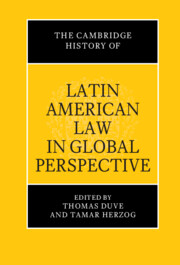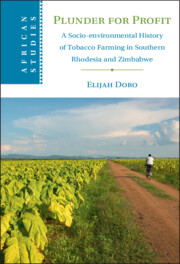280 results
Introduction
-
-
- Book:
- The Cambridge History of Latin American Law in Global Perspective
- Published online:
- 15 January 2024
- Print publication:
- 08 February 2024, pp 1-17
-
- Chapter
-
- You have access
- Open access
- HTML
- Export citation
2 - How to Approach Indigenous Law?
-
-
- Book:
- The Cambridge History of Latin American Law in Global Perspective
- Published online:
- 15 January 2024
- Print publication:
- 08 February 2024, pp 95-140
-
- Chapter
-
- You have access
- Open access
- HTML
- Export citation

The Cambridge History of Latin American Law in Global Perspective
-
- Published online:
- 15 January 2024
- Print publication:
- 08 February 2024
-
- Book
-
- You have access
- Open access
- Export citation
A Class of Their Own: Newspaper Obituaries and the Colonial Public Sphere in Lagos, 1880–1920
-
- Journal:
- History in Africa / Volume 50 / May 2023
- Published online by Cambridge University Press:
- 13 December 2023, pp. 99-125
-
- Article
-
- You have access
- Open access
- HTML
- Export citation
8 - Orphans of the Uprising: Late Mughal Echoes and 1857
-
- Book:
- Music and Musicians in Late Mughal India
- Published online:
- 09 November 2023
- Print publication:
- 23 November 2023, pp 219-247
-
- Chapter
- Export citation
Chapter 18 - Decolonizing the Medieval Literary Curriculum
- from Part IV - Canon Revisions
-
-
- Book:
- Decolonizing the English Literary Curriculum
- Published online:
- 02 November 2023
- Print publication:
- 09 November 2023, pp 349-366
-
- Chapter
-
- You have access
- Open access
- HTML
- Export citation
1 - Introduction
-
-
- Book:
- The Anticolonial Transnational
- Published online:
- 10 August 2023
- Print publication:
- 24 August 2023, pp 1-16
-
- Chapter
-
- You have access
- HTML
- Export citation
Chapter 13 - Sun-Drowned Streets and Wasted Lives
- from Part III - Revolutions and Empires
-
-
- Book:
- The Nation in British Literature and Culture
- Published online:
- 20 July 2023
- Print publication:
- 10 August 2023, pp 225-240
-
- Chapter
- Export citation
28 - Children’s and Young Adult Literature
-
-
- Book:
- The Cambridge History of the Australian Novel
- Published online:
- 28 June 2023
- Print publication:
- 27 July 2023, pp 472-487
-
- Chapter
- Export citation
19 - Frontier Massacres in Australia, 1788–1928
- from Part III - Nineteenth-Century Frontier Genocides
-
-
- Book:
- The Cambridge World History of Genocide
- Published online:
- 23 June 2023
- Print publication:
- 04 May 2023, pp 461-480
-
- Chapter
- Export citation
24 - The Crime of the Congo
- from Part IV - Premonitions
-
-
- Book:
- The Cambridge World History of Genocide
- Published online:
- 23 June 2023
- Print publication:
- 04 May 2023, pp 585-608
-
- Chapter
- Export citation
21 - Genocide in Northern Australia, 1824–1928
- from Part III - Nineteenth-Century Frontier Genocides
-
-
- Book:
- The Cambridge World History of Genocide
- Published online:
- 23 June 2023
- Print publication:
- 04 May 2023, pp 508-534
-
- Chapter
- Export citation

Plunder for Profit
- A Socio-environmental History of Tobacco Farming in Southern Rhodesia and Zimbabwe
-
- Published online:
- 06 April 2023
- Print publication:
- 13 April 2023
1 - Sticking It to the Man
- from Part I - Genealogies
-
-
- Book:
- The Cambridge Companion to K-Pop
- Published online:
- 02 March 2023
- Print publication:
- 09 March 2023, pp 11-27
-
- Chapter
- Export citation
1 - Violence, a Colonial Curse
-
- Book:
- Election Violence in Zimbabwe
- Published online:
- 23 February 2023
- Print publication:
- 02 March 2023, pp 8-34
-
- Chapter
- Export citation
Chapter 19 - South Asian Poetry
- from Part II - Nations and Voices
-
-
- Book:
- A History of World War One Poetry
- Published online:
- 18 January 2023
- Print publication:
- 12 January 2023, pp 309-328
-
- Chapter
- Export citation
1 - Rebels and Refugees
-
- Book:
- Staging Haiti in Nineteenth-Century America
- Published online:
- 18 November 2022
- Print publication:
- 01 December 2022, pp 33-60
-
- Chapter
- Export citation
African Medicine in the Atlantic World - Healing Knowledge in Atlantic Africa: Medical Encounters, 1500-1850 By Kalle Kananoja. Cambridge: Cambridge University Press, 2021. Pp. 320. $99.99, hardcover (ISBN: 9781108491259); $80.00, e-book (ISBN: 9781108865302).
-
- Journal:
- The Journal of African History / Volume 63 / Issue 3 / November 2022
- Published online by Cambridge University Press:
- 02 December 2022, pp. 436-438
- Print publication:
- November 2022
-
- Article
- Export citation
Chapter 1 - The Transcripts of (Post)Colonial Modernity in Ulysses and Accra
- from Part I - Scope
-
-
- Book:
- The New Joyce Studies
- Published online:
- 01 September 2022
- Print publication:
- 08 September 2022, pp 21-34
-
- Chapter
- Export citation
5 - A Poetological Narration of the Nation
- from Part II - History, Fictions, and Factions
-
- Book:
- Decolonizing African Knowledge
- Published online:
- 23 June 2022
- Print publication:
- 14 July 2022, pp 99-124
-
- Chapter
- Export citation



